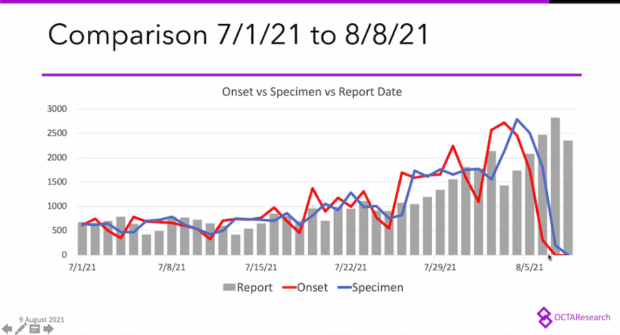OCTA Research defends R-naught model for projecting COVID trends
MANILA, Philippines — OCTA Research on Monday maintained that its model for making projections for COVID-19 cases is “useful,” amid a looming House probe on the independent monitoring group’s methodologies and qualifications to assume pandemic figures.
OCTA Research fellow Guido David noted that the reproduction number of COVID-19 cases, or the number of new cases that could stem from one case, is the primary indicator that the group uses in making forecasts for new infections.
“Reproduction number is the indicator that we use to forecast new cases. It measures the speed or strength of the pandemic. The positivity rate, we also use it as a strong supporting indicator,” he said during an online forum hosted by the Philippine-American Academy of Science and Engineering.
David said OCTA Research only sources data from the Department of Health (DOH). He said the DOH publishes three types of data: report date or the date when a case was reported, specimen date or the date when a specimen was taken, and onset date or the date of onset of illness.
He noted that these data are correlated.
Article continues after this advertisement“This is the picture if we align the report date with the specimen date two days ago and onset date three days ago. We can see that there is a fairly high level of correlation,” he said, citing data from July 1 to August 8.
Article continues after this advertisement“If we use the report date, it’s very highly related with the onset date from three days ago. It’s not 14 days ago as some critics are claiming that our data is wrong and unreliable. In fact, it’s highly reliable as long as we understand that what we were looking at yesterday is minus three days, four days.
“Is that a big error or problem? No. Because firstly we understand that what we are looking at is really three to four days old, and that’s fine. That’s not a big change in our projections,” he explained.
Dr. Edsel Salvaña, an infectious disease expert and member of the DOH’s Technical Advisory Group, earlier criticized OCTA for using “incomplete” and “erroneous” data, thus producing “problematic” projections.
Salvaña claimed OCTA is calculating the COVID-19 reproduction number based on cases that were reported in the last two weeks, which he said is not valid since there are backlogs in the reporting of cases.
David, however, noted that the reproduction number has been used worldwide to project the number of cases and determine trends for infections.
“Case reports, which we use, have a high degree of correlation with onset of cases minus three days and data specimen minus two days so there is a small lag but that is something we accept,” he stressed.
Meanwhile, another OCTA Research fellow and molecular biologist Fr. Nicanor Austriaco said that the group’s modeling is useful despite criticism from some experts.
“Our model was useful and we actually know because we’ve been told that hospitals in the NCR use these forecasts to make plans for optimal patient care,” he said. “Despite those who have called us alarmists two weeks ago, the Delta surge is worse than what our projections had anticipated.”
Austriaco then reiterated that the government and independent experts should fight against COVID-19 as their common enemy.
“The DOH modelers and OCTA modelers, we are working together as Filipino scientists to serve our country against a common enemy. And the common enemy is COVID-19, and so I think it’s wrong to talk about whether their model or our model is better or worse. Both our models are useful.
“Both our models should be used to inform public policy and for the most part, we are looking at trends, and I believe both our models see the same trends and the same overall shape of the pandemic,” he said.
“I am so grateful for the FASSSTER team for their work,” he added, referring to the DOH’s disease surveillance team for making their own COVID-19 projections.

